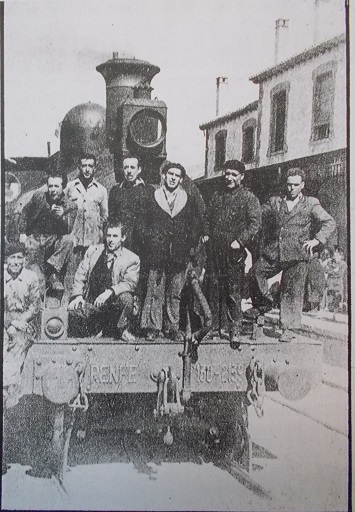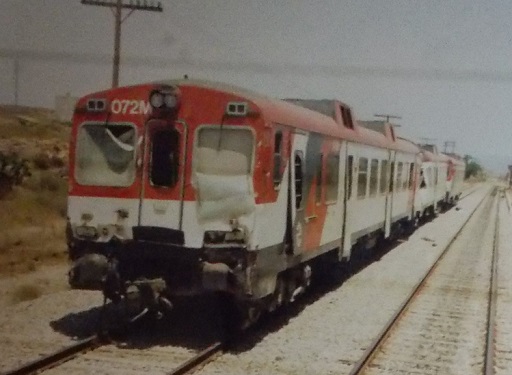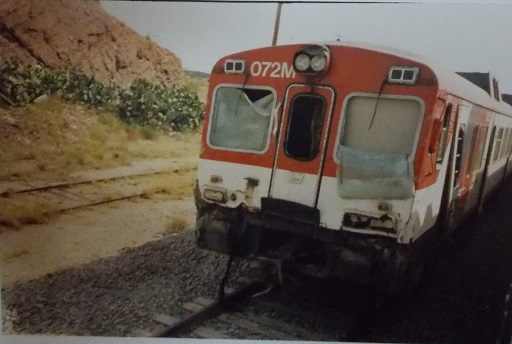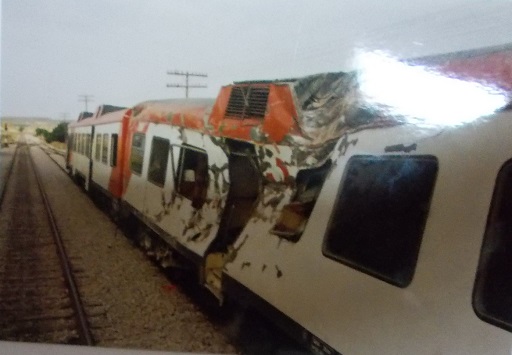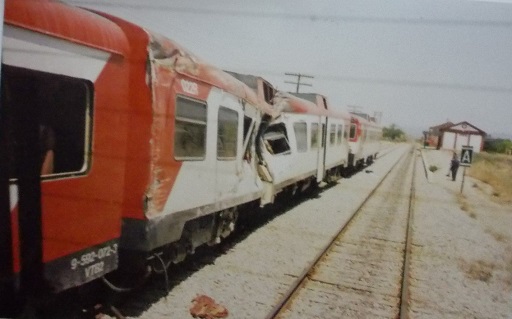ACCIDENTS
The following appear to be the only recorded accidents pertaining to The GSSR although there were surely many more.
| October 1889 | Death of young person in Pilar de Jaravía Station. This was before the line opened, and the person was run over by a locomotive transporting building materials. |
| 15th March 1890 | |
| 29th May 1890 | A worker from Vélez-Blanco who was working on the railway line in Lorca was trapped by a ballast train on the Boquera del Jurado iron bridge at km14/597. His head and left arm were crushed and he died instantly. |
| 26th August 1890 | A Landslide during construction in the area of Moreda (Granada). There were three deaths and various injuries. |
| 7th May 1891 | A collapse of the bank of a cutting at km66 of the line due to the infiltration of water, burying a number of workers and resulting in the loss of four lives and 5 to 6 serious injuries. |
| 10th May 1891 | One of the station managers in the area between Lorca and Huércal-Overa received an electric shock during a storm, presumably due to lightning striking a telegraph line. He fell to the floor and suffered some contusions. |
| 17 November 1891 | The failure of scaffolding during the construction of Puente de la Cañada near Arboleas resulting in the death of Joaquín González Sirvent leaving a wife and two small children. |
| 18 January 1893 | Locomotive No 9 "ALBOX" pulling train No 52, for unknown reasons derailed in Almanzora station. There were no casualties, but the train was delayed two hours. |
| 25 June 1894 | 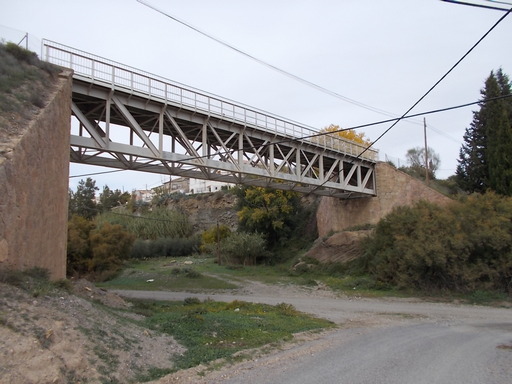 During the installation of the 30 metre span across Rambla Jauca en Los Zoilos one of the large red hot rivets being hammered fell down and started a fire in the wooden scaffolding that was supporting the iron bridge. The fire could not be extinguished and so it passed on to 1,500 sleepers that were piled up in preparation for track laying, all of which were lost. The fire started at 6 pm and continued through the night until midday of the 26th whereby there was nothing left to burn. Mr Kennedy arrived the same day to inspect the problem. During the installation of the 30 metre span across Rambla Jauca en Los Zoilos one of the large red hot rivets being hammered fell down and started a fire in the wooden scaffolding that was supporting the iron bridge. The fire could not be extinguished and so it passed on to 1,500 sleepers that were piled up in preparation for track laying, all of which were lost. The fire started at 6 pm and continued through the night until midday of the 26th whereby there was nothing left to burn. Mr Kennedy arrived the same day to inspect the problem.Note: hot riveting was used extensively - the rivets being heated to red heat and then inserted into the hole where someone on the other side would hit the rivet hard with a sledge hammer until a head formed. As the shank cooled, it would pull together tight the two pieces of metal. See modern riveting and from 1928 (from 2:30 minutes). In 1894 there were no pneumatic hammers as seen in these videos, so the hammering had to be done manually. |
| 3 November 1894 | During a thunderstorm, lightning struck a telegraph post between Serón and Purchena, causing it to fall onto the track whereby it was hit by a locomotive and was thrown aside. However, the cable became caught up with some of the rolling stock which dragged out some of the other posts. Some of the passengers became so hysterical that they tried to alight the train. |
| November 1894 | A child who tried to climb up onto a wagon of a ballast train that was in use in track laying between Baza and Caniles was caught up in the wheels and his dead macerated body was found. |
| 26 June 1900 | Due to disastrous flooding, the Albox Bridge lost its two central spans of 80 metres that were 5 metres (17ft) above the river floor. |
| October 1906 | "From the goods van of 253, and in company with the pointsman Mr Ballesteros we were watching out, when in front of my eyes there was the vision of a great catastrophe: a locomotive with a train loaded with ore was coming toward us, and in the irredeemable moments of danger, I applied the brake with all my force, the others with whistle in mouth sounding the emergency whistle, trying to avoid the cataclysm, but all was useless, the trains, as if pushed by an unstoppable force closed rapidly. To save my life, I jumped out onto the embankment losing consciousness as the collision occurred. When I regained consciousness, I went to see the magnitude of the catastrophe. Apart from my injuries, what was worse was my pain for my co-workers and the destruction caused to the equipment. I will tell you what happened afterwards: the death of co-workers, major injuries to others and the imprisonment of those that the law considered culpable". Boletín May 1921 |
| 14 September 1907 | 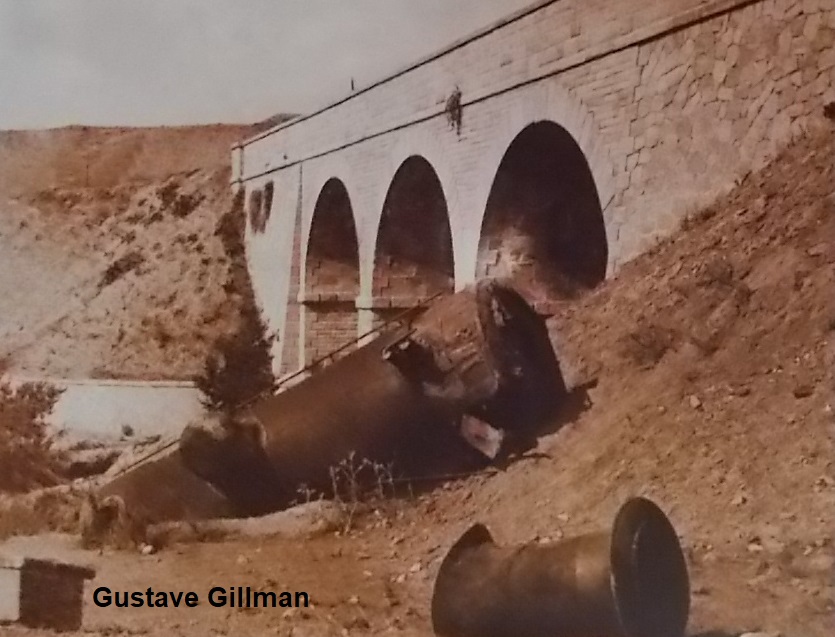 Explosion of the boiler of No 2 (LORCA). This was due to the build up of lime (see History), a perennial problem for The GSSR. The accident happened on the stretch between Tíjola and Purchena here. Both the driver and fireman were killed. Explosion of the boiler of No 2 (LORCA). This was due to the build up of lime (see History), a perennial problem for The GSSR. The accident happened on the stretch between Tíjola and Purchena here. Both the driver and fireman were killed.The accident resulted in The GSSR having to look at ways of resolving the hard water problem. With respect to the failure, it can be assumed that a pressure release valve became clogged up with limescale thus allowing the boiler pressure to increase above critical thus resulting in the failure of the boiler. However, this would also suggest that the crew were somewhat remiss in their vigilance of the boiler pressure gauge. A boiler over-pressure should result in a member of crew releasing a manual pressure release valve or, if seized, the dampening or 'dropping' of the fire. The other possibilty was that the crew allowed the water level in the boiler to fall below the top of the firebox, thus distorting it. There is an excellent photograph of the debris by Gustave Gillman in the book 'Almería Insólita' by Juan Roberto Gillman Mellezo and Juan Grima. We will never know exactly what happened but it goes to show how dangerous steam locomotives are when not used correctly. |
| 16 January 1917 | Military train No 352 ran over a cavalryman at Km. 18.700 without serious injury. |
| 16 January 1917 | At Km. 58.700 there could have been a serious accident when a goods train met a police vehicle coming in the opposite direction. The situation was saved by the skills of the engine driver Mr. Ibañez, who was able to stop the train 250m from the police vehicle. |
| 16 March 1918 | José Juan De Haro, a worker in El Hornillo had a fall from a great height whilst at work. He was found to have a serious head injury and was transferred to the hospital. He was visited in hospital by The Director, George Boag and Mr. Browne, the Head of Traction. The accident caused a paralysis that rendered him unable to return to work. |
| 7 April 1918 | Train 253 fire on arrival at Almanzora Station. Fire extinguished by station staff and those on the train thus avoiding a conflagration. It is unclear why Train 253 suffered so many fires. Possibilities that come to mind are a siezed wheel bearing, arson and sparks from the locomotive's chimney. |
| 12 April 1918 | Train 253 fire on arrival at Cantoria Station. Fire extinguished by station staff and the train crew thus avoiding a conflagration. See 7 April 1918. |
| July 1918 | Domingo Ibart Ferrez suffers a fracture of the right tibia due to slipping whilst unloading a tyre in the workshops. |
| 9 July 1918 | Train 253 fire between Puerto Lumbreras and Almalajejo |
| August 1918 | A number of minor accidents in the workshops - a lathe operator received contusions of the left foot; an apprentice received a contusion of the left hand; a lathe operator receives burns on his left arm. |
| October 1918 | El Hornillo worker Alfonso Cáceres, 58, suffered a broken leg. The doctors decided that to save his life, they would have to amputate. Unfortunately, in spite of this, he died. The widow received the sum of 1,500 pesetas. |
| 26 November 1918 | Boiler explosion of No 1 (MURCIA) near Cantoria Station throwing shrapnel great distances. Unfortunately No51 was stationary in the station which resulted in five persons injured but thankfully no fatalities. Luckily, it was the smoke-box end of the boiler (front) which saved the crew. The service was rapidly resumed by replacing the locomotive with another. |
| 14 December 1918 | Fire in two wagons of straw of Train 253 at Km 75.600. Fire extinguished and 38 bales were saved. |
| 21 December 1918 | Fire in a wagon of straw of Train 253 at Km 45.150. Contents of wagon totally destroyed. |
| 31 December 1918 | 60 year old woman killed by Train B 239 at Km 93.522 by throwing herself in front. She died immediately. |
| February 1919 | A mother bringing lunch to her son who was working in the workshops at Águilas Station. She was run over by a locomotive that was shunting at the time. |
| 25 February 1919 | Fire in Train 253 loaded with fertilizer. The staff fought bravely to extinguish the fire before it could spread, receiving burns in the process. |
| 27 February 1919 | Fire in a wagon of fertilizer in Train 253 at Km 28.000. Extinguished due to the heroics of the train staff and those of Las Norias Station. |
| August 1919 | Francisco Reche Navarro, the manager of El Hornillo recieves an injury to his hand due to a lump of iron ore being unloaded from a wagon. |
| 20 August 1919 | Minor injury in Cantoria when the guard shut a train door and trapped his fingers of the left hand. |
| 7 March 1920 | Workshop accident - two workers receive injuries to their feet due to glass. |
| 10 March 1920 | A child, trying illegally to board Train 51 in Lorca Station falls and receives injuries to face, hand and feet, and a tear in his right thigh. A passenger rescued him and took him to Puerto Lumbreras Station where he received treatment in a clinic. This event resulted in The Director General writing to the mayors of Lorca and Baza requesting vigilance by the local police in preventing young children accessing the platforms and boarding the trains illegally as this was becoming a serious problem. |
| 15 April 1920 | Train 2, whilst stationary in El Apartadero the staff noticed smoke coming from a wagon of sulphur. With great courage, the staff isolated the wagon and then proceeded to unload the smoking bags of sulphur, risking poisoning from the gases and smoke being emitted. They managed to suffocate the fire within 50 minutes and continued the journey with the offending wagon half full. |
| June 1920 | Derailment of a mineral train due to obstacles that had been placed on the track. Fortunately, no-one was injured. A few days later, there were more obstacles placed on the track without incident. |
| June 1920 | Persons unknown caused the derailment of a mineral train. Fortunately, no-one was hurt. A few days later, obstacles were placed on the rails. |
| 7 July 1920 | The mother of the level crossing lady hit by Train No 1 (MURCIA) at Km 6.337, dying whilst in the hands of a local doctor. |
| February 1921 | Workshop accidents: a burnt left hand; contusions; contusion to left foot. |
| 30 October 1922 | Accident in Águilas Station whereby a foreman was loading items from Ways and Works and a trough fell on his left leg causing a complex contusion and a tibial fracture. He was given First Aid by the Station Manager and soon received treatment from The GSSR doctor Sr. Alejandro Santamaría who removed a shard of bone from his leg. He was returned to his home whereby the doctor administered anti-tetanus vaccine. |
| 18 June 1923 | Fire in a wagon of fertilizer in Train 253 near to Puerto Lumbreras Station. It was noticed that heat was coming from a wagon of fertilizer. The staff reversed the train back to Puerto Lumbreras Station whereby they split the train. The wagon of fertilizer couldn't be saved in spite of heroic efforts and the wagon and its contents burned to cinders. |
| September 1923 | A second lieutenant travelling Cartagena to Almería alighted at Puerto Lumbreras Station, returning to the train as it was leaving and boarding a different coach. In trying to climb between the coaches to his coach, he fell and the train ran over his legs. Dr Alejandro Santamaría was called from Águilas Station to assist the medical staff at the scene. The patient was taken to Águilas Hospital. |
| 25 May 1927 |  The worst accident that happened to The GSSR in all of its time running the railway was the catastrophe at Pulpí between iron ore train No244 and mail train No 2. Ten people were killed and twelve seriously injured. In addition, Engine 23 (BACARES), a brake van, 2 coaches, 2 wagons of esparto and nine 35 ton iron ore wagons were destroyed. The worst accident that happened to The GSSR in all of its time running the railway was the catastrophe at Pulpí between iron ore train No244 and mail train No 2. Ten people were killed and twelve seriously injured. In addition, Engine 23 (BACARES), a brake van, 2 coaches, 2 wagons of esparto and nine 35 ton iron ore wagons were destroyed.The order of events were as follows: 13.22 - A mixed train No 2 with Loco No 9 (ALBOX) leaves Almendricos on time. 13.42 - The train arrives at Pulpí. On arrival, a message was sent to Almendricos saying that they could release the iron ore train. 13.42 - Iron ore train 244 leaves Almendricos. On passing down the incline, the driver notices that his brakes have failed and that he is gaining speed. He blows his whistle continuously to warn the staff. Almendricos contact Pulpí and the mail train leaves in the direction of Jaravía under full power but was unable to attain sufficient velocity to avoid the accident. The iron ore train 244 (BACARES) smashed into the back of No 2 at Km 10.220 at a velocity of approximately 56Km/h. Seven people died immediately and three more later, and there were more than twenty injured, twelve seriously. 14.45 - train No 3 leaves Águilas Station with staff from The GSSR including George Boag, Drs Alejandro Santamaría and Calero, Sr. Lloret (Chief of Comercial Services), Sr. Orts, Sr. Gimenez Serrano and company medical auxiliaries. These employees, along with doctors from the town, helped the injured and the dying. The survivors were transferred to Águilas Hospital among others. So, why did the brakes fail? The braking systems on The GSSR were the vacuum type. Unlike modern braking systems which work on compressed air, the vacuum brakes used by The GSSR were not fail-safe, meaning that if there were a loss of vacuum (badly connected hose for example), then the brakes on the whole train simply would fail. 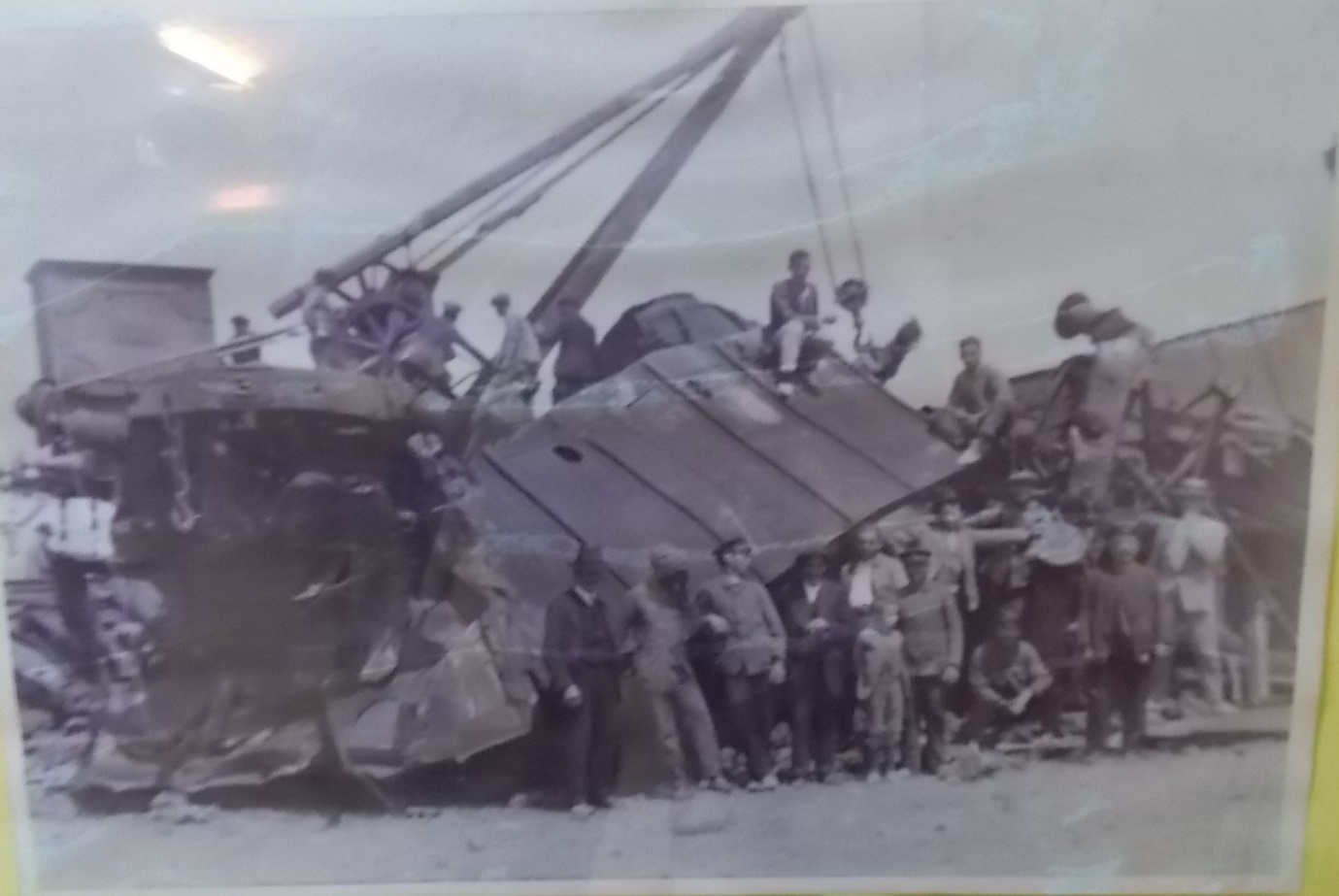 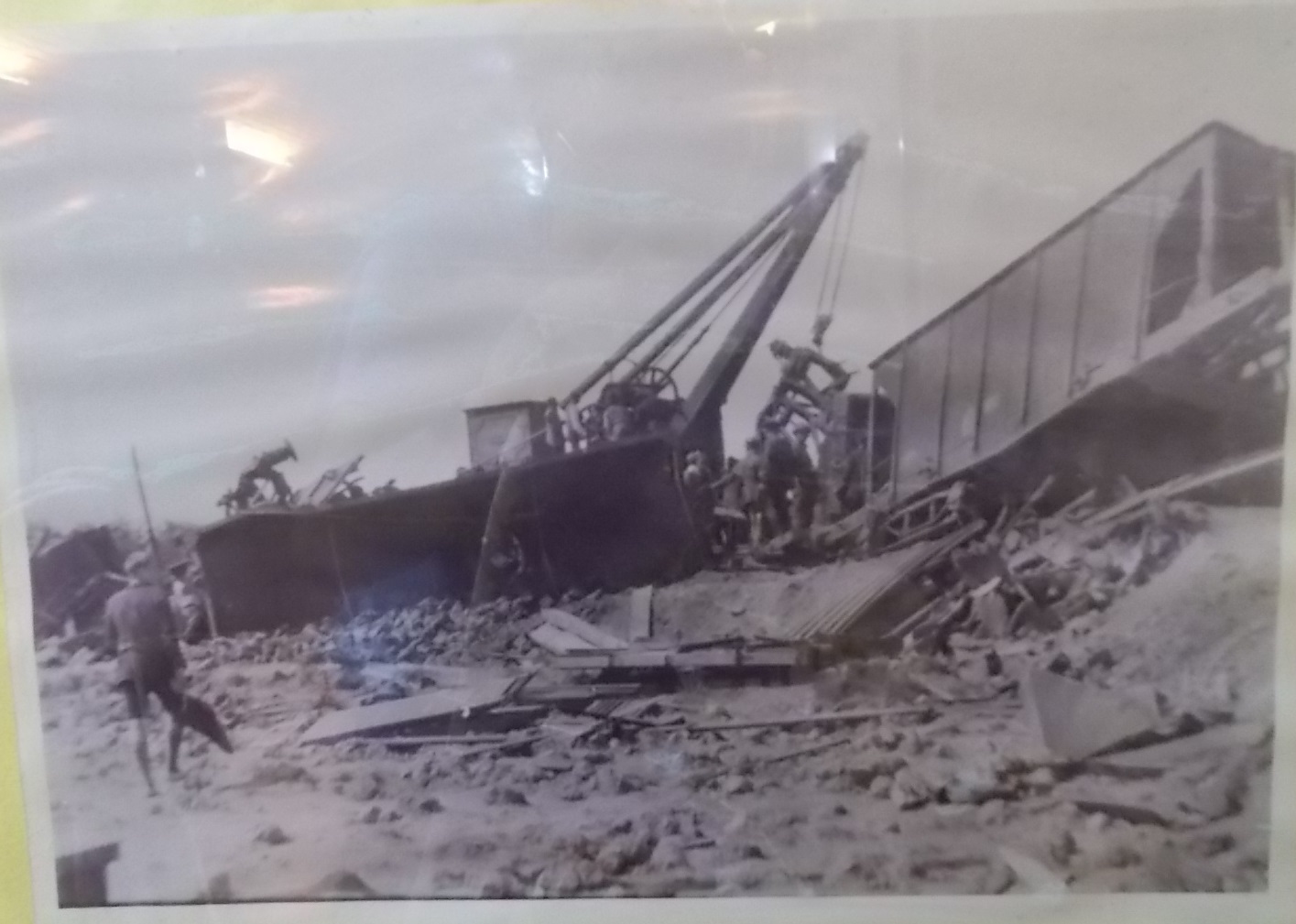 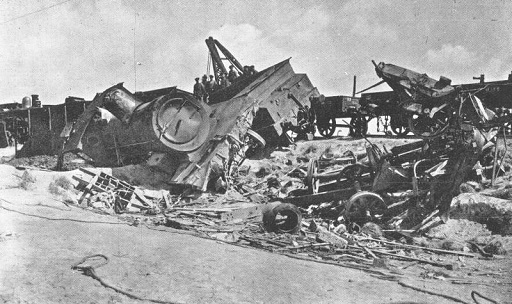 |
| 28 June 1928 | 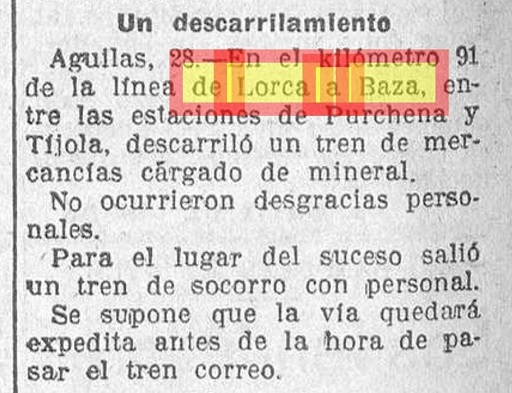 Between Purchena and Tíjola stations, at Km91, a goods train derailed. Between Purchena and Tíjola stations, at Km91, a goods train derailed.There were no injuries. A relief train was despatched. It is to be assumed that the track was repaired before the mail train passed. |
| 30 June 1928 | 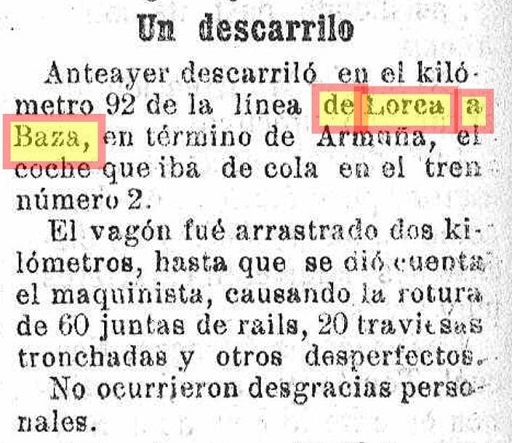 At Km92 in the borough of Armuña, a coach derailed from No 2, being dragged for two kilometres until the driver of the train realized. This caused 60 fishplates and 20 sleepers to be damaged as well as other damage. No-one was hurt. At Km92 in the borough of Armuña, a coach derailed from No 2, being dragged for two kilometres until the driver of the train realized. This caused 60 fishplates and 20 sleepers to be damaged as well as other damage. No-one was hurt. |
| 8 October 1929 | 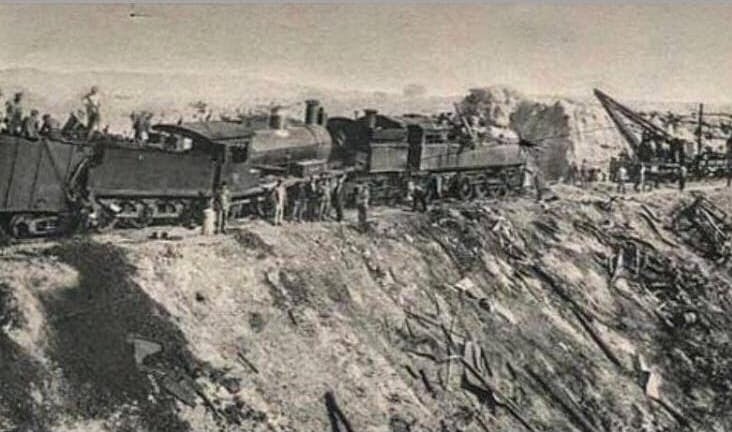 During shunting in Huércal Overa Station, thirteen wagons became disconnected from Train 254 and started rolling down the incline towards Almajalejo, gaining speed and colliding with iron ore Train No 2 at Km 43.100. The crew of Train No 2 had little or no warning due to the curvature of the track in that area. The wagons mounted the double headed train and flew down the side of the embankment. The wagons were full of esparto which, along with the two locomotives, caught fire which promptly resulted in a huge conflagration. A rescue train was rapidly dispatched to the site with The Director General (George Boag) and other technical staff. One of the duties they had was to remove the dead body of the driver (some say it was the brakeman) from the carnage. Because the debris was blocking the track, they had to look at a way of constructing a diversion, which would prove very difficult considering the topography of the area, and the detritus from the accident. As a result of a huge amount of work by all concerned, and materials brought from stores, the line was re-opened on 13th, just five days later. Locomotive No 50 was a write-off and No 21 badly damaged. In addition, there were eight wagons completely destroyed, a third class coach, eight series W wagons (iron ore) and all of the goods that were loaded in the 13 wagons. The material loss alone cost The GSSR 500,000 pesetas. During shunting in Huércal Overa Station, thirteen wagons became disconnected from Train 254 and started rolling down the incline towards Almajalejo, gaining speed and colliding with iron ore Train No 2 at Km 43.100. The crew of Train No 2 had little or no warning due to the curvature of the track in that area. The wagons mounted the double headed train and flew down the side of the embankment. The wagons were full of esparto which, along with the two locomotives, caught fire which promptly resulted in a huge conflagration. A rescue train was rapidly dispatched to the site with The Director General (George Boag) and other technical staff. One of the duties they had was to remove the dead body of the driver (some say it was the brakeman) from the carnage. Because the debris was blocking the track, they had to look at a way of constructing a diversion, which would prove very difficult considering the topography of the area, and the detritus from the accident. As a result of a huge amount of work by all concerned, and materials brought from stores, the line was re-opened on 13th, just five days later. Locomotive No 50 was a write-off and No 21 badly damaged. In addition, there were eight wagons completely destroyed, a third class coach, eight series W wagons (iron ore) and all of the goods that were loaded in the 13 wagons. The material loss alone cost The GSSR 500,000 pesetas.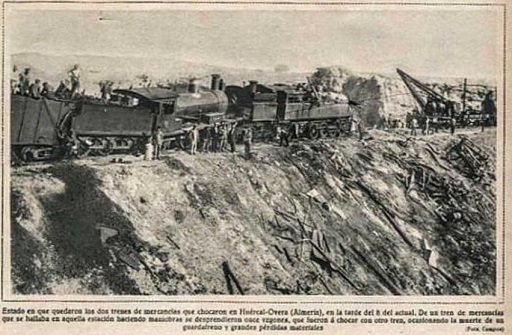 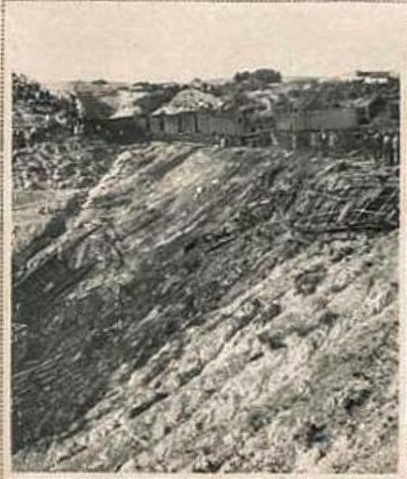 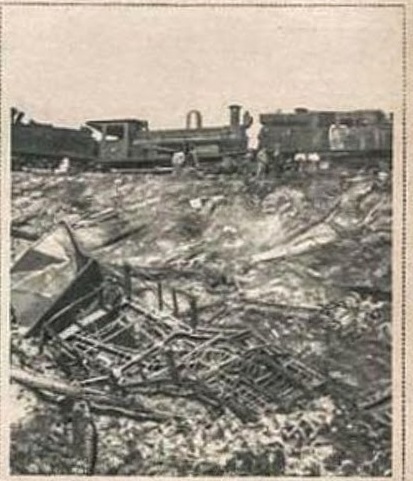  |
| 21 January 1930 | 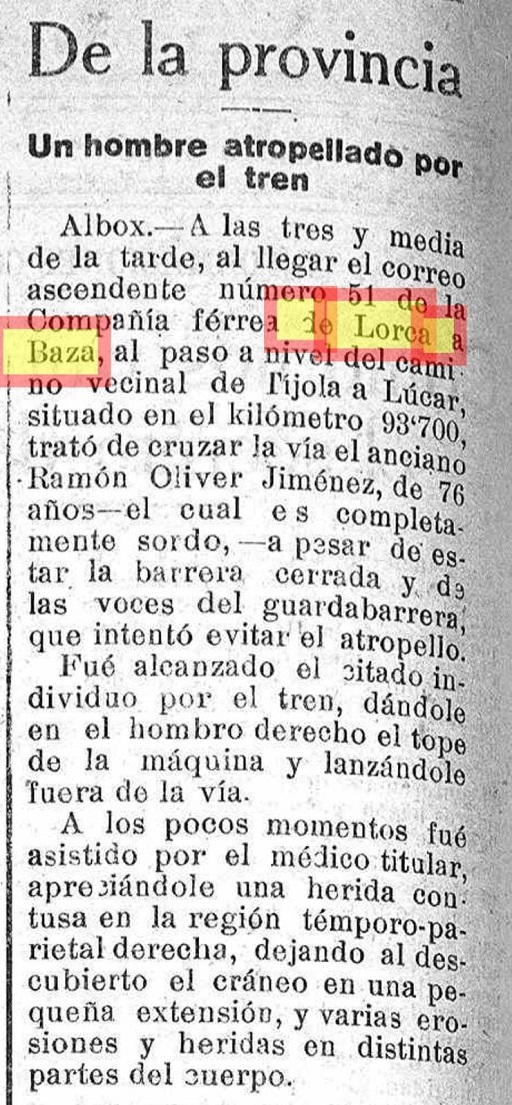 At 3:30pm as mail train 51 passed across the level crossing of the Tíjola to Lúcar track at Km 93.700, Ramón Oliver Jimínez, 76, who is stone deaf, passed the closed barrier and crossed without hearing the shouts of the crossing technician. At 3:30pm as mail train 51 passed across the level crossing of the Tíjola to Lúcar track at Km 93.700, Ramón Oliver Jimínez, 76, who is stone deaf, passed the closed barrier and crossed without hearing the shouts of the crossing technician. The train closed on him, hitting him in the right shoulder therefore tossing him from the track. Moments later, he was attended to by a local doctor and was found to have received a contusion in the right temporal parietal area, slightly exposing the cranium as well as various injuries to the body. |
| 9 August 1939 | At Km37 a number of first class coaches derailed. A rescue train took the passengers to Las Norias station. No-one was hurt. |
| 10 June 1949 | A goods wagon on the mail train derailed at Km21. No-one was hurt. Workers from Almendricos station attended and were able to replace the goods van on the track, and return the railway to normal running. |
| 23 July 1955 | An individual of some 30 - 40 years climbed on the mail train at Km23 whereby he was killed in the process and his body was horribly mutilated. The condition of his clothes suggested that he was a tramp. |
| 8 September 1955 | 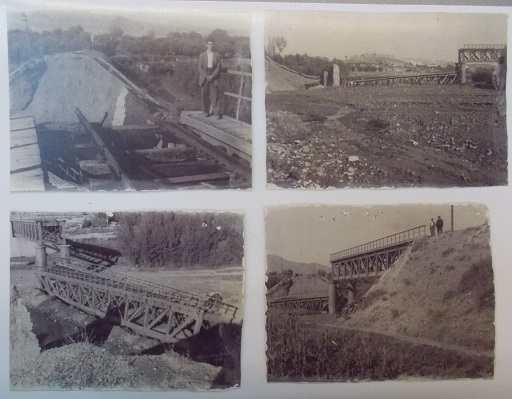 After a deluge and flooding, one of the two 30 metre spans of Río Valcabra Bridge near to Caniles was washed away. A train was stopped by a worker, preventing it from falling into the void. The bridge was built in 1892 and rebuilt and re-opened on 1st October 1955 at 01:40hrs only 22 days after the disaster. |
| 1980s | 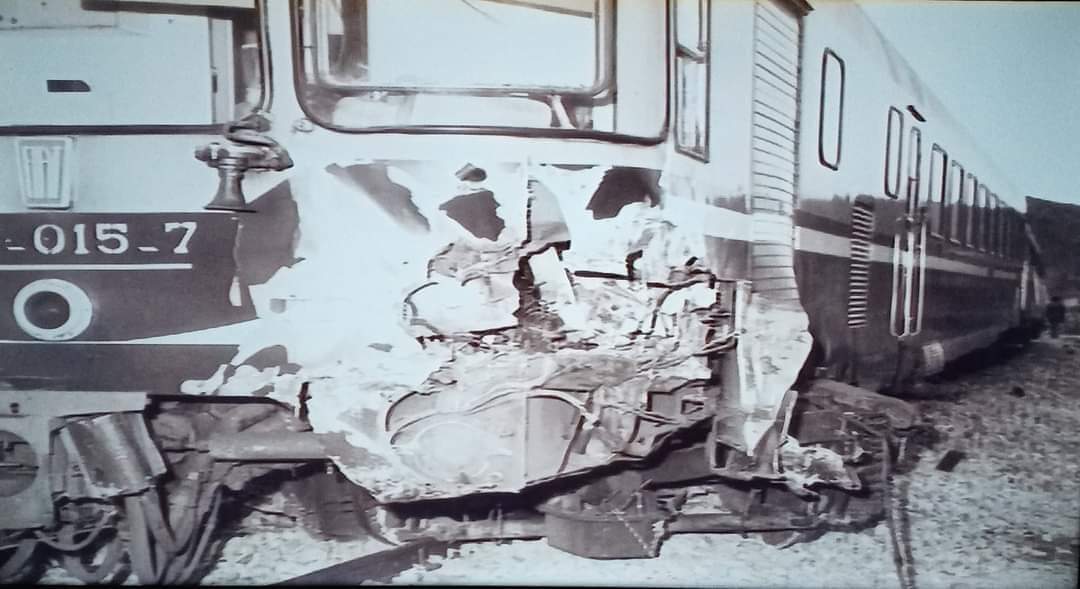 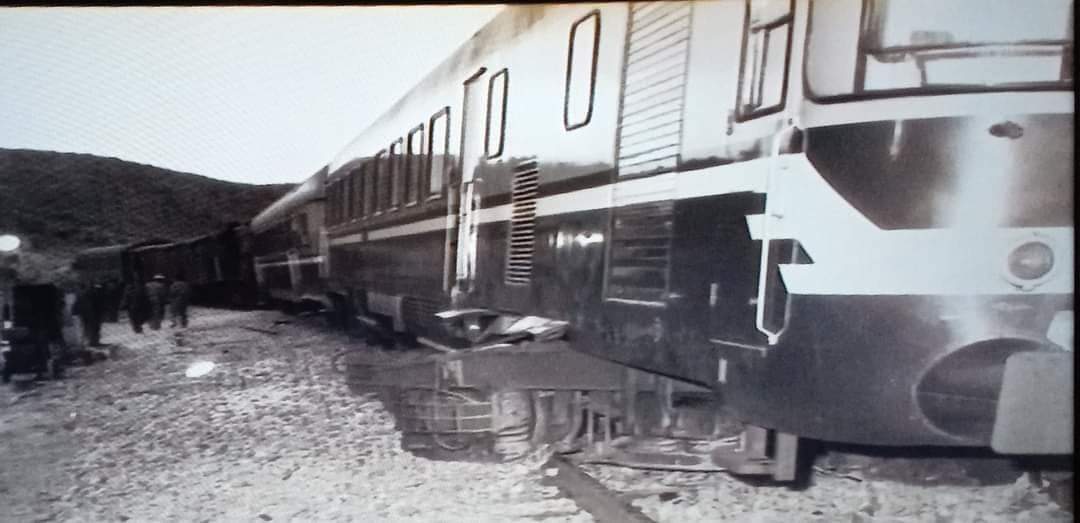 Accident between Zújar-Freila and Baúl stations. Photograph by Vicente R. Mellado. Thanks to Juan Antonio Serrano Navarro for supplying the information. Accident between Zújar-Freila and Baúl stations. Photograph by Vicente R. Mellado. Thanks to Juan Antonio Serrano Navarro for supplying the information. |
| 15 November 1985 | 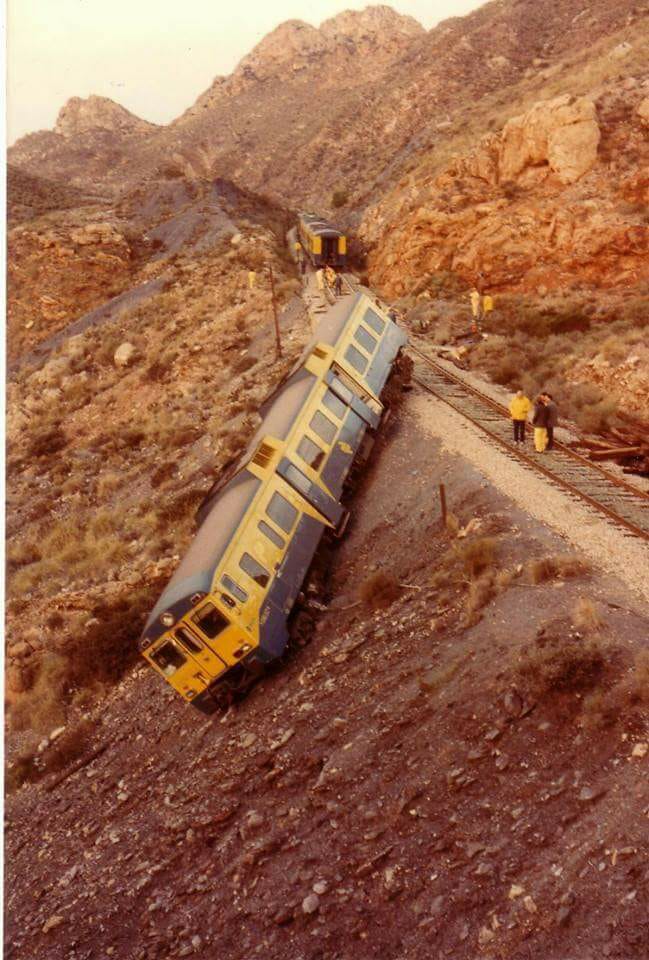 The driver Adolfo Sánchez López; relates his story thus: “During an incredible storm with torrential rain and destructive wind, I managed to get to the train and start it. With me in the cab was Bonfacio from Ways and Works who wanted to inspect the cuttings and embankments for damage. In one of the tunnels there was a huge thud when we hit a loose stone. On arrival at Pulpí it was still pouring. It was then that I noticed that the snow guard was somewhat bent. The journey to Alicante and back saw torrential rain such that I had to drive at reduced speed. On leaving the No 1 (Km14) tunnel the accident happened by hitting a boulder that had rolled down onto the track due to the rain. I broke my nose and in applying the emergency brake, I broke four fingers of my right hand. Fortunately, there were no other serious injuries. The telephone didn't work so we had to evacuate the passengers through the quarry to be taken by two buses from Jaravía Station”. The driver Adolfo Sánchez López; relates his story thus: “During an incredible storm with torrential rain and destructive wind, I managed to get to the train and start it. With me in the cab was Bonfacio from Ways and Works who wanted to inspect the cuttings and embankments for damage. In one of the tunnels there was a huge thud when we hit a loose stone. On arrival at Pulpí it was still pouring. It was then that I noticed that the snow guard was somewhat bent. The journey to Alicante and back saw torrential rain such that I had to drive at reduced speed. On leaving the No 1 (Km14) tunnel the accident happened by hitting a boulder that had rolled down onto the track due to the rain. I broke my nose and in applying the emergency brake, I broke four fingers of my right hand. Fortunately, there were no other serious injuries. The telephone didn't work so we had to evacuate the passengers through the quarry to be taken by two buses from Jaravía Station”. |
| 2 June 1998 | 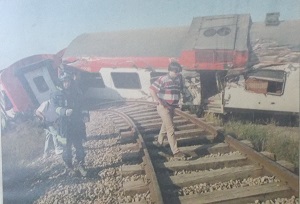 This accident was due to a heavy lorry crossing a barrierless level crossing (which has now been blocked off) against the red light. The local unit crashed into the lorry resulting in the death of one 19 year old lady and 49 injuries. |


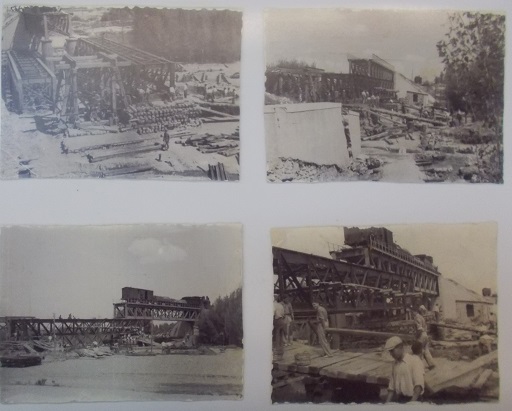
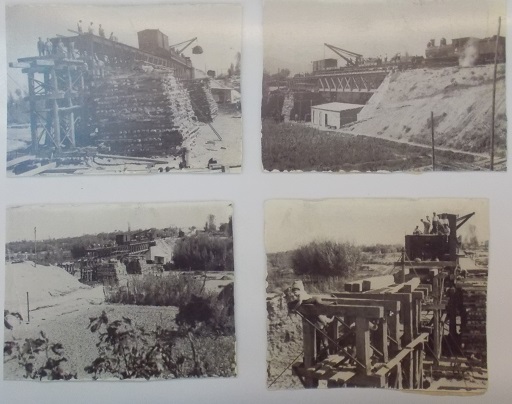
_1.jpg)
_2.jpg)
